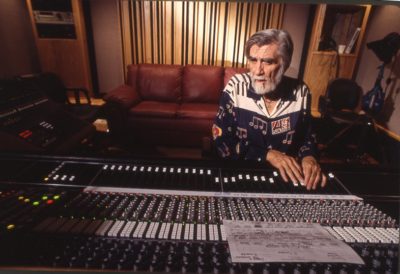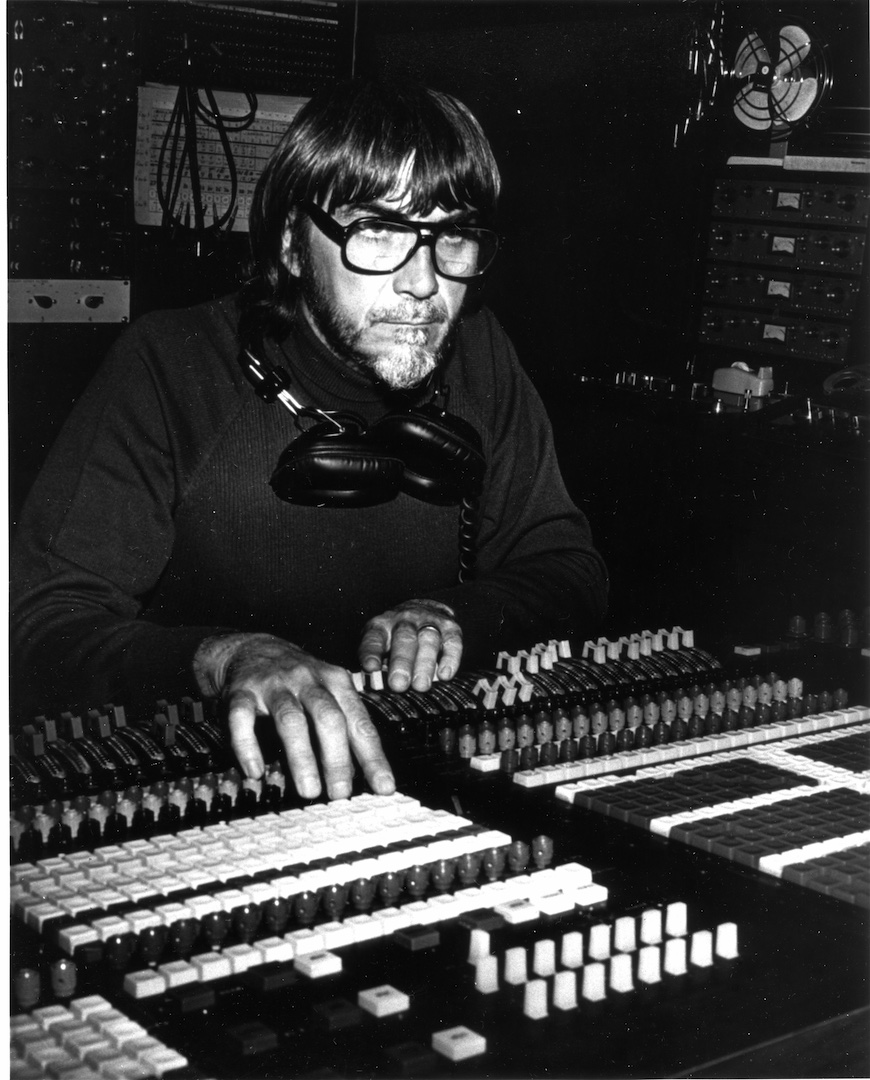The Pioneers of Audio Engineering: Tom Dowd
In this new series, we’ll be discussing the pioneers of audio engineering—our innovators, giants, and audio forebearers.
If we had an audio Mt. Rushmore, these are the faces that would be on it. The first engineer in this series is Tom Dowd, the “Father of the Atlantic Sound.”
Who is Tom Dowd?
If you Google “incredibly interesting life”, you’ll see a picture of Tom Dowd.
Okay, maybe not. But you should.
Dowd performed nuclear research for the infamous Manhattan Project during World War II. He also created the first ever 8-channel console with sliding faders in order to record some of the biggest artist of all time: Ray Charles, Allman Brothers, Eric Clapton, Aretha Franklin, Otis Redding, John Coltrane, Dizzy Gillespie, Thelonius Monk, Cream, Rod Stewart, Lynyrd Skynyrd, the list goes on and on… and on… and… on.
As the main recording engineer for the legendary Atlantic Records for 25 years, his technical excellence and ability to think outside the box made him a true pioneer in the field.
He was an engineer during the golden years of music for several genres, working through multiple eras and recording all styles. Somehow, he was able to not only stay relevant through all of them, but remain in high demand at the top of the industry throughout.
To put the gravity of Dowd’s legacy in context, the first hit song he recorded was Eileen Barton’s, “If I Knew You Were Comin’ I’d’ve Baked a Cake”, released in 1950. One of the very last albums he worked on was Joe Bonamassa’s New Day Yesterday, released in 2000. That’s a full 50 years of recording and producing major releases.
Not only did he continue to record for over half a century, but he was at the forefront of the industry in adapting to changing technology. He was there for the change from hand-me-down radio gear and a mono disc cutter, to stereo recording systems, to 24 track tape machines, all the way to digital recording with practically unlimited tracks and digital effects.
Early Life
Thomas John Dowd was born in 1925 in New York City. His mother was a opera singer and his father a stage manager, in charge of theater productions. He played piano and violin from a young age and eventually learned tuba and string bass. Tom excelled at math and science and, after graduating from Stuyvesant High School in Manhattan at 16, got a job working at the Office of Scientific Research and Development at Columbia University.
When he turned 18, he was drafted into the military and sent off to basic training. After that training, he was immediately sent back to Columbia University. His orders read, “United States Army Corp of Engineers: Manhattan District,” which later became known as “the Manhattan Project”.
That’s right: The man responsible for recording “Layla”, “Respect” and “Stand by Me” also helped develop the atomic bomb. During his stint on the Manhattan Project, Dowd operated a “cyclotron” particle accelerator, performed density tests of various elements, and recorded statistics, as part of the “Neutron Beam Spectography” division. He didn’t find out until 1945 that his work during this time was used to develop the bomb that ultimately ended the second World War.
After the war, Dowd finished his service and wanted to complete his degree in nuclear physics at Columbia University, since he was only short a few credits. He asked the school if they would acknowledge his work during the war and give him the credits he needed to graduate. Unfortunately, because his work on the Manhattan Project was top secret, Columbia refused to honor any of it. Now, in order to graduate, Dowd would have to return to Columbia and learn the physics that predated what he used in his time in the military.
Unbeknownst to them, Columbia’s decision changed the course of recorded music forever. Dowd decided to forgo finishing school in favor of a summer job at a demo studio, owned by the Fisher publishing company.
The Atlantic Years
In the late 1940s, Ahmet Ertegun, the head and founder of Atlantic Records, was recording at Apex a recording studio in New York. He had requested to work with the best engineer at the time, who he was told was a “German Professor.”
According to Ertegun, this professor was very strict, and would not let the engineers turn up the bass or drums “too loud”. At the time, bass and drums weren’t often heard prominently on records. This was due in part to mic techniques, but also because of issues cutting bass directly to disc (the needle could physically skip if you recorded low end too hot).
The next time Ertegun showed up to record, the German professor was not available, so in walked a young Tom my Dowd who had been assigned to the session. At the time, Dowd was a young kid who raised a few skeptical eyebrows, but wasn’t afraid of breaking rules that his older, conventional contemporaries would never think of—like using multiple microphones on sources and tracking bass and drums so listeners were actually able to hear them. After that session, Ahmet Ertegun decided he loved Dowd so much that he made sure he recorded just about every Atlantic record.
Dowd was eventually put in charge of building the Atlantic Records studio, which was located on West 56th Street in Manhattan. In the beginning, the studio was an office space during the day and at night, the desks would be pushed against the walls and groups would gather around microphones in the inner office. The outer office would be used as the control room, where Tom would record with a small mixer and tape recorder. Even the stairwell would be utilized as a reverb chamber.
Tom was a big fan of Les Paul, and after listening to Les Paul’s records featuring 5 guitars and 3 vocal overdubs, he couldn’t figure out how Les was doing it. Eventually, Dowd learned the secret: Les had his own 8-track recorder. In 1958, Tom Dowd, convinced Jerry Wexler (a partner and producer at Atlantic) to purchase the second Ampex 8-track tape recorder ever manufactured. This put them technologically ahead of other studios for many years.
To truly understand just how far advanced this was, the Beatles at Abbey Road were still using pairs of 4 track machines nearly a decade later while recording Sgt. Peppers Lonely Hearts Club Band.
(There’s a fun reenactment in the 2004 movie, Ray, in which Dowd introduces Ray Charles to 8-track recording in the middle of a session, who then tells the backup singers to leave so he can record all their parts himself.)

Since Atlantic had a new 8-track machine, they also needed to build a console to accommodate these extra 4 tracks. Tom immediately went to work on a new console. He had a longstanding issue with the hand-me-down radio equipment they had been using, and their large rotary knobs. Being a piano player, he liked the idea of having control over multiple channels at once. He sourced some slide wires, and decided to use those instead. This was the first time sliding faders were ever used on a recording console.
Dowd recorded all styles and genres, ranging from artists on Atlantic’s jazz roster, like John Coltrane and Charles Mingus, to pop and rhythm & blues legends like Ray Charles and Dusty Springfield. He eventually went on to record rock bands like Cream, and is credited with shaping the sound of Southern rock, as longtime producer for the Allman Brothers Band and Lynyrd Skynyrd.
Later Life
In the late 1960s, Dowd left Atlantic Records to work as a freelance producer and, in 1967, moved to Miami where he worked primarily at Criteria Sound Studios. He made records right up until his death in 2002. Later on, he was posthumously inducted into the Rock and Roll Hall of Fame, where his daughter, Dana Dowd, accepted his award in his honor.
Tom Dowd was there when Ray Charles was recording “I’ve Got a Woman”, when Ben E. King recorded “Stand by Me,” and when Duane Allman played his famous slide solo at the end of Eric Clapton’s “Layla.”
Think about that for a moment: He was right there, in the studio, arranging microphones and hitting the record button, when all of these songs were put to tape. Dowd spent a life actively involved in creating songs that are completely embedded in the minds of countless millions, and that make up the very fabric of our collective culture and history. We hear these songs on the radio, in movies, on television shows. We sing these songs in the shower.
Tom Dowd was right there when each of these iconic performances took life, and played an active role in those productions turning out quite the way they did. It’s a legacy any of us could aspire to.
David Silverstein is an audio engineer who works at Sabella Studios. You can find more of his writing on his blog, Audio Hertz.
Please note: When you buy products through links on this page, we may earn an affiliate commission.









betterfredthandead
July 27, 2017 at 5:01 pm (8 years ago)One can always tell an article written by someone who’s never ‘ been there’…there was absolutely nothing “infamous” about the Manhattan Project.
Your article introduces the Ampex AG 440-8 about 8 or 10 years way too early.
Paul commissioned Ampex to build a 1/4-tk, then a 1/2-tk recorder (stereo) as he was using a half dozen Full track mono machines to ‘overdub’ his production’s. He also pioneered in tape-delay & reverb.
Les then wanted to be able to lay a track down and then add another in syncronization on the same machine…thus “Syl-Sync” was born.
The trick was in developing the precision technology to manufacture the ‘head stacks’.
There were also-3 track machines. Then in the late ’50’s the 4 track was built using four-1/2 track head stacks recording to half inch tape…then came the 8 track on 1″ tape…which didn’t last very long as hot on the heels was 16, 24 machines using Ampex 2″ tape video transports. An independent company even built a 48 tracker using a different transport!!!
Just a little add-on to your otherwise excellent article…
a/k/a: Grateful Fred
Danwriter
July 27, 2017 at 6:34 pm (8 years ago)I’m glad I got to spend some time with Tom, when I lived in the Miami area in the late 1990s. He was on O2 by then, due to emphysema, but amazingly energetic. And that great attitude that I’m sure was as crucial to his success as his technical skill and creative acumen, never left him, either. Everyone was important to Tom. His daughter, Dana, remains his biggest fan.
Mike Chanter
July 29, 2017 at 12:56 am (8 years ago)Always wanted to meet him, but never got the chance….my best friends niece is Dana….and my cousin has worked with many of rocks greats including eric clapton, who tom recorded and was friends with….so, yes tom was a real innovator.